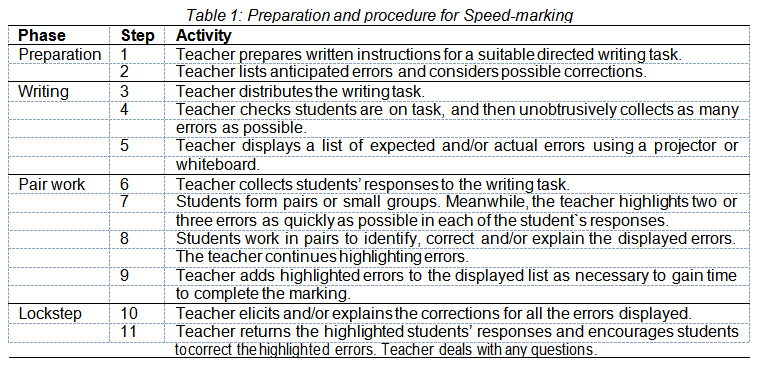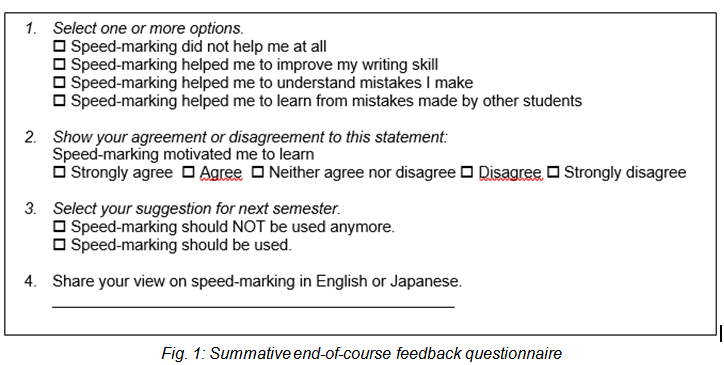Speed-Marking: A Case Study

Abstract
This case study investigates the use of speed-marking [1] with Japanese students in the school of computer science at a public university in Japan. One of the most time-consuming tasks for a teacher of English is responding to writing. The novelty of speed-marking is that teachers respond immediately to the work written in class while students identify, correct and explain errors that the teacher displays to the whole class. Three classes of sophomore students (n=82) with a mean TOEIC score of 381 participated in this study. All the students were enrolled in a compulsory integrated skills intermediate English course comprising two 100-minute sessions per week for seven weeks. According to the precourse survey, almost all the students had no affinity for, interest in or motivation to learn English. Seven speed-marking activities on different topics were completed. Mid-course formative and end-of- course summative feedback from students regarding speed-marking was extremely positive. Students particularly appreciated receiving prompt feedback, noting that with delayed feedback they had often forgotten both the original task and the problems they had faced when writing. For the teacher, speed- marking is challenging as it is necessary to respond to each text rapidly. The benefits, however, are that class time passes quickly, students receive prompt feedback and possibly the most important benefit: there is no need to respond to writing out-of-class.
Table of Contents:
1. Background
1.1 Problem
1.2 Cause
1.3 Proposed solution
2. Speed-marking
3. Case study
3.1 Participants
3.2 Data collection
4. Results
4.1 Student evaluation
4.2 Teacher evaluation
5. Conclusions
1. Background
1.1 Problem
Teachers of academic writing with large classes draw the short straw on marking load. Teachers preparing students for written examinations may be faced with an onerous marking load. This is particularly true for teachers who want to provide their students the best possible written corrective feedback; and it can, without careful planning, snowball into a huge volume of marking far outstripping the time spent in class. For example, a university teacher with three classes of 25 students who sets a 500-word writing task once a week for a 15-week semester needs to respond to half a million words.
1.2 Cause
Although the validity of empirical evidence supporting the use of corrective feedback is contested [2, 3, 4], many teachers feel the need to respond to writing, often using written corrective feedback [5, 6, 7]. The underlying cause is the perceived necessity for the teacher to read and provide corrective feedback on all the writing tasks. There are cogent arguments for the use of self reflective, peer feedback and automated feedback using either computer programmes or online tools [8, 9]. Students, however, when surveyed tend to state a preference to receive feedback from the teacher [10, 11].
Most students expect their teacher to correct surface-level errors and believe that such feedback is beneficial [12, 13]. In fact, not giving that feedback may negatively affect students’ evaluation of teaching.
1.3 Proposed solution
Many teachers would prefer not to have to respond to writing outside of class, the ideal solution would appear to be responding during class, giving them immediate rather than delayed feedback.
Timely feedback is not only preferred by many students, but has been shown to be effective [14]. One way to free up time during class is to get students actively engaged on a different task, giving the teacher the opportunity to read and respond to their written work. In the original version of Speed- marking [1], the alternative tasks suggested involved the creation and use worksheets based on model answers to the writing task. However, in this revised version of Speed-marking no prior preparation of alternative materials is needed. The alternative task is error correction. The errors used are ideally those made by the students, but it is also possible to recycle errors made by a previous cohort of students or use a list of anticipated errors.
2. Speed-marking
The preparation for speed-marking is straight forward. The classroom procedure can be divided into three phases: writing, pair work and lockstep. In the writing phase, the teacher aims to collect errors that students can discuss in the pair work phase. During the pair work phase, students discuss displayed errors together while the teacher aims to deal with each of the students’ responses. In the lockstep phase, the teacher enables the students to identify and be able to correct the errors. The specific steps within each phase are described in Table 1.

3. Case study
This case study was conducted at the University of Aizu in the school of computer science at a public university in Japan by a university teacher. Details on the participants and the method of data collection are given below.
3.1 Participants
All participating students were enrolled in a mandatory credit-bearing integrated skills English language course comprising two 100-minute sessions per week delivered over seven weeks. Three classes of sophomore students (82 students in total) participated in this study. The mean TOEIC score of participants was 381, which according to the test creators, Educational Testing Service, categorizes the students as independent users of English (approximately equivalent to B1 in the CEFR framework). According to a pre-course survey, almost all the students had no affinity for, interest in or motivation to learn English which is in line with most research on motivation levels to learn English in the Japanese context [15]. The participating teacher was an experienced teacher of writing who had previously used speed-marking.
3.2 Data collection
Seven speed-marking activities on different topics were completed. The writing phase lasted 15 minutes and while the two feedback phases (pairwork and lockstep) took between 20 and 30 minutes.
Evaluations of perception of speed-marking from both the teacher and the students were compiled. Student evaluations were collected via two feedback questionnaires housed on the learning management system.
Formative mid-course feedback was received from one class. The rubric for the mid-course formative feedback questionnaire was: “Should I continue to use speed-marking? Is it useful for you for? Please share any ideas you have in English if possible.”
Summative feedback was received from all three classes. The four-question survey is reproduced in Figure 1.

Teacher evaluation was collected using a reflective log and comments on each speed-marking activity.
4. Results
The results of the formative and summative student evaluations are summarized in subsection 4.1 and the results of the teacher reflection are given in subsection 4.2.
4.1 Student evaluation
Overall, both the mid-course formative and end-of-course summative feedback from students regarding speed-marking was extremely positive.
In the mid-course formative feedback, all twelve respondents agreed speed-marking was useful and worth continuing with future classes. Student comments included:
[student 1] “Useful but I don’t like [sic]”
[student 2] “Honesty troublesome, useful! [sic]”
These comments can be interpreted as agreement that the activity is useful but that students are required to make more effort than they anticipated. Students also commented that they were able to learn from the mistakes made by other students.
Although 82 students were initially enrolled on the course, ten students dropped the course and three students did not complete the questionnaire. Sixty-nine respondents completed the summative feedback questionnaire.
In the end-of-course summative feedback students particularly appreciated receiving prompt feedback, noting that with delayed feedback they had often forgotten both the original task and the problems they had faced when writing.
Almost all students (97.1%, 67 people) noted that speed-marking helped them with 63.8% (44 people) stating it helped them improve their writing skill, nearly three-quarters (72.5%, 50 people) noting that it helped them understand their own mistakes and just under half (47.8%, 33 people) stating that they learned from the mistakes of other people. However, two respondents (2.9%) stated that speed-marking did not help them et al.
Just over four out of five students (82.6%, 57 people) agreed or strongly agreed that speed- marking motivated them to learn. Ten students neither agreed nor disagreed, while two (2.9%) disagreed.
Student views on speed-marking varied from “not bad” to “fabulous”. Many comments did not take the form of full sentences and could be interpreted in different ways. One of the clearer comments is given below:
[student 3] “英文を書くにあたって注意すべきところを自分のミスや他の生徒のミスから 学ぶことができた” [I was able to learn from my own and other student’s mistakes to identify where to be careful when writing in English.]
Numerous comments made positive comments about learning, enjoying and improving from speed- marking. One such comment is:
[student 4] “I was fun. I learned. I improved my skill [sic.]”
Approximately 15% of the comments related to the timing of the class rather than speed-marking, e.g.
[student 5] “It is hard to wake up early morning”.
[student 6] “it is very interested class [sic], but I was so sleep [sic] every day because it is 1st class (of the day)”.
The lack of enthusiasm for early morning classes comes as no surprise, but given that the questionnaire was focused on speed-marking, it is clear that student agenda differs from the teacher agenda. There were no negative comments at all about speed-marking.
4.2 Teacher evaluation
For the teacher, speed-marking was challenging as it is necessary to respond to each text rapidly. The benefit, however, outweighed the drawback as class time passed quickly, students were able to receive prompt feedback and possibly the most important benefit: there is no need to respond to writing out-of-class.
5. Conclusions
Although this case study could be characterized as a popularity survey of speed-marking, the results are extremely positive. The next step in the investigation of the usage of speed-marking is to determine the efficacy of speed-marking with a large-scale experimental study.
Contributo selezionato da Filodiritto tra quelli pubblicati nei Proceedings “11th International Conference Innovation in Language Learning - 2018”
Per acquistare i Proceedings clicca qui.
Contribution selected by Filodiritto among those published in the Proceedings “11th International Conference Innovation in Language Learning - 2018”
To buy the Proceedings click here.



